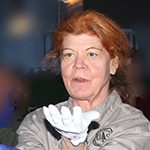Fisheries & Wildlife

Dec. 15, 2017
Craig P. Paukert
Paukert is the Leader of the US Geological Survey, Missouri Cooperative Fish and Wildlife Research Unit in the School of Natural Resources. His research is in collaboration with state and federal agencies to help them with their research needs related to climate change adaptation strategies for fish and fisheries, conservation and management of large river fishes, and stream fish conservation at the local and landscape scale. Paukert has a Ph.D. from South Dakota State University, an M.S. from Oklahoma State University, and a B.S. From the University of Minnesota. Prior to arriving at MU in 2010, he worked with USGS…

Dec. 15, 2017
Rebecca North
Research in the North group is focused on addressing the question: What controls algal biomass of inland waters? North’s team focuses on the effects of multiple stressors on nutrient cycling, bioavailability, and primary production in Missouri water bodies with particular attention to the source and timing of nutrient loading and the response of the receiving water body. Ecosystem stressors include, but are not limited to: climate change, landscape modification (i.e., agricultural, urban, and industrial applications), eutrophication, and invasive species (i.e., zebra mussels). North’s research is conceptually driven and applies field, lab, and quantitative approaches to studying issues in watershed and…

Nov. 10, 2017
Jared E. Decker
IDENTIFYING LOCI RESPONDING TO SELECTIONIn 2012 Decker published a method, now called Generation-Proxy Selection Mapping, to identify loci responding to current selection. In this analysis, birth date (as a surrogate to generation number) is fit as the dependent variable in a mixed model equation. Variants that have changed in frequency rapidly due to selection are strongly associated with birth date, thus the method identifies regions under selection. The mixed model equations correct for demography, relatedness, and population structure within the data. We have previously used this method in Angus cattle using approximately 45,000 SNPs. In 2021, Decker’s group published…

Oct. 27, 2017
Michael Byrne
Educational background Ph.D. Wildlife and Fisheries Science, Louisiana State University Courses taught Principles of Wildlife Management Ornithology…

Oct. 27, 2017
Sybill K. Amelon
Amelon’s studies focus on ecology of bat species related to population demography, behavioral ecology, resource selection, habitat use, diet/nutritional analysis and energy dynamics. A range of techniques are used including temperature sensitive radio-telemetry to monitoring of bats outfitted with passive transponders (PIT tags) and population genetics to help understand social behavior, winter / summer movements, roosting habitat selection and different overwintering strategies. Her disease research focuses on understanding and mitigating physiological impacts caused by WNS in bats. Mortality rates in affected hibernacula generally exceed 75% and have been documented as high as 99-100%. Focus is on mitigation tools to increase…
- « Previous
- 1
- 2